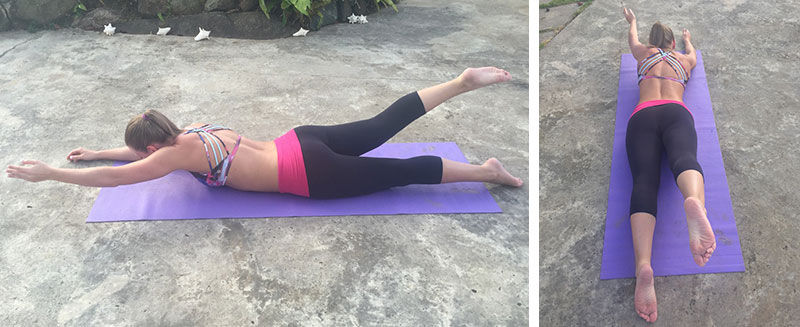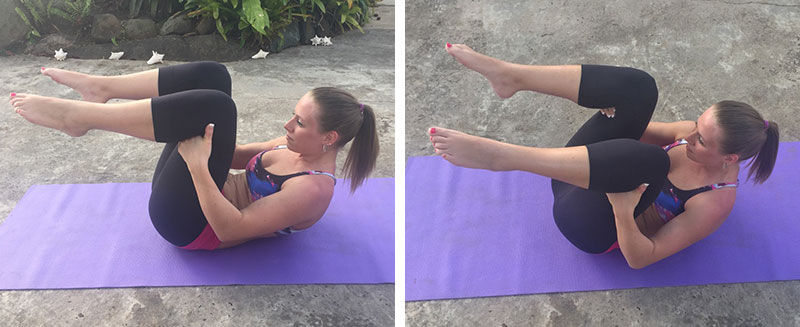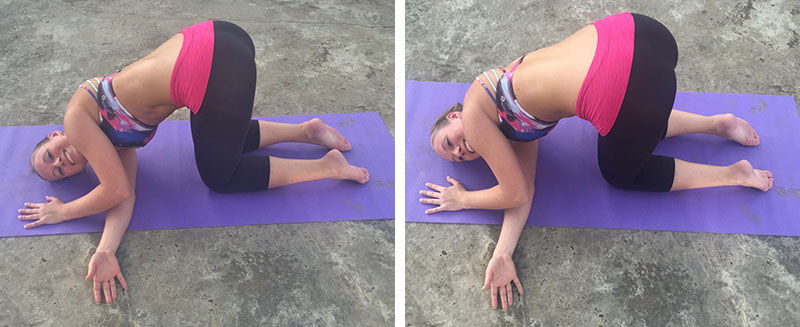Warming up the spine before getting out of bed can help clients go about their activities of daily living in a more productive, less painful way. The following routine, which is appropriate for clients who have no contraindications or special issues like osteoporosis, provides a sound biomechanical start to the day.
The ACE Pointers Course for Group Fitness recommends that warm-ups begin in the sagittal plane, because this mirrors how most of us get up in the morning—we sit at the edge of the bed, walk to the bathroom, and sit or stand in it. Most of our first daily movements occur in the sagittal plane and, for this reason, a sound approach for spinal care includes a sagittal plane warm-up.
The spine’s two movements in the sagittal plane include flexion and extension. Next, adding frontal plane to the spine helps warm up both the deep and more superficial core muscles we need to use when we side-stretch, side-bend and reach for things at the side of the bed. These spinal actions include spinal lateral flexion. Finally, after warming up the spine in the sagittal and frontal planes, the most dynamic movement for the spine includes spinal rotation in the transverse plane. This systematic, tri-planar approach is a proven method for warming up the spine.
The following routine is ideally performed while still in bed. To be sure, the floor can provide ample space for this routine, but the idea here is to include these moves before the feet even hit the floor to promote healthy spinal self-care for the rest of the day. For each of the following moves, remind clients to make this two-part core connection: First, draw the navel to the spine to activate the transverse abdominis, and second, contract the pelvic floor muscles to create a strong connection to the core from the inside out.
Swimming Wake-up for Spinal Extension

This movement improves posture, warms up the spinal extensors and glutes, and even prepares the body for digestion during the day. Furthermore, as a counter pose, it balances posture with needed extension after many hours of sleep, which usually includes more flexion than extension.
Set-up and Movement: Lie prone on the bed with the feet plantarflexed and spread about the distance of the sitz bones. Flex the shoulders out in front of the body, thumbs facing the ceiling, and palms facing each other. Pressing the left foot and side of the right hand into the bed, extend the right hip to extend the spine. Try to keep the biceps of the left arm next to the left ear so that the arm moves with the spine as the spine engages in extension. Keep a neutral neck as if holding a tennis ball between the chin and chest. Lower the spine and arm back to the bed and repeat on the other side. Breathe comfortably with each repetition, changing sides each time, and try to create a smooth flow of this swimming-like movement for about 12 repetitions.
Rolling Wake-up for Spinal Flexion

This movement helps to massage the spine for the activities of the day ahead and stretches the spinal extensors.
Set-up and Movement: Lie supine and bring the knees into the chest, carefully placing the hands behind and adjacent to the knees. Flex the spine, bringing the nose between the knees. While simultaneously breathing and bracing the core, slowly roll forward and backward, up to 12 repetitions, to massage the spine. Be careful to massage the lumbar and thoracic vertebrae, but keep both the neck’s cervical vertebrae and the toes off of the bed. Try to exhale with each action that moves the body forward.
Wagging the Tail to the East and West

This movement helps prepare the spine for frontal plane movement and helps engage the quadratus lumborum to strengthen its role as a spinal stabilizer during gait for the rib-and-hip connection.
Set-up and Movement: From a supine position, turn over and push up to an all-fours quadruped position, with the palms under the shoulders and the knees under the hip bones. Keep a neutral neck so that the entire length of the spine remains as parallel to the bed as possible. Imagine a sheet of “coffee table” glass over the spine, with the body as the base. Move parallel to this glass, neither flexing nor extending the spine. Imagine having a long tail extending from the last lumbar vertebra. Slowly “wag” the tail to the right and look over the right shoulder to see the tail. Repeat this same movement on the left. Repeat this sequence for up to 12 repetitions on each side, trying only to move parallel to the glass on the back.
Down and Under Criss-cross Preparation

This movement helps prepare the spine for transverse plane rotation and helps engage the obliques for daily rotational activities. It also helps prepare the spine for other Pilates moves involving rotation, such as the Seated Saw and Criss-Cross.
Set-up and Movement: Begin in an all-fours position; abduct the right shoulder to the right like an airplane wing. Slowly slide this arm under the body, past the left side of the body until the right shoulder and right ear can rest on the bed. Only reach to a point of discomfort, not pain; continue breathing and return to the starting position. Repeat on the other side. Continue for 12 repetitions in a slow, rhythm-like fashion.
Criss-Cross

This traditional movement helps strengthen the obliques and rectus abdominis and prepares the body for rotation throughout the day.
Set-up and Movement: Lie supine in spinal flexion. Place the fingertips behind the head at the ears, elbows pointing to the sides and slightly behind. Extend the right knee and flex the left. Rotate the core toward the left knee, keeping the elbows out of peripheral vision. Exhale and rotate to the opposite side and hold for a moment. Repeat the entire sequence for up to 12 repetitions.




 by
by 






